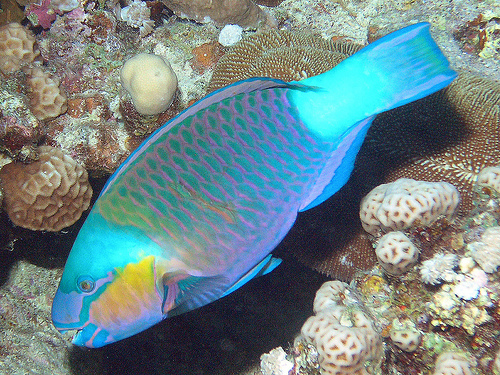Parrotfish do not fly!
- Parrotfish are mainly found in reefs or coastal areas and include 90 species of fish, that are native to the tropics and sub tropics of the seas around the globe.
- Parrotfish were previously from the family Scaridae, however, they have been reclassified and now belong to the family Labridae , which is the family of wrasses, and are now known as the sub-family Scarinae.
- ‘Parrotfish’ are named as such, due to the beak-like mouth the fish have, and are used to chomp on hard objects, especially coral from which they extract algae.
- Parrotfish can grow to be 30 to 130 centimetres (one to four feet) in length, and have a lifespan of up to seven years.
- Usually at night, some parrotfish species encase themselves in a mucus covering, which protects the fish from predators, probably by blocking its odour and acting as an alarm.
Parrotfish
Image courtesy of Rob/Flickr
- Parrotfish diets consist mainly of vegetational matter, usually algae growing on coral, although sometimes other marine animals are eaten.
- Parrotfish produce up to 90 kilograms (198 pounds) of sand a year, from ground, indigestible coral that exits the fish as sand.
- It is common for female parrotfish to change gender and become males during their life, and females can lay 100s of floating eggs at a time, that deposit on coral.
- Parrotfish change colours while growing, often starting dull and becoming bright and colourful, sometimes imitating other fish.
- The meat of parrotfish is considered a luxury in some countries, and in a few historical cases, it was served only to the king.
Bibliography:
Parrot Fish, 2013, National Geographic, http://animals.nationalgeographic.com.au/animals/fish/parrot-fish/
Parrotfish, 2013, Wikipedia, http://en.wikipedia.org/wiki/Parrotfish








why my parrott fish lie on one side and dont swim any more.